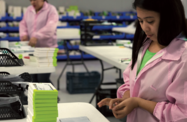Solid gains by the Philippine manufacturing industry are set to continue through the remainder of the year, but increased investment will be needed to boost production in the long term.
The manufacturing sector is approaching the upper limits of its production capacity, with plants operating at an utilisation rate of 84%, according to the World Bank’s “Philippines Monthly Economic Developments” report for September 2016.
Although there was a 10.1% surge in the Volume of Production Index for total manufacturing in July – compared to 0.1% growth for the same month in 2015 – which boosted output and revenue, the World Bank report noted that capacity utilisation rates had hardly changed in the past four years.
“Unless businesses actively invest in expanding production capacities, capacity constraints may limit growth prospects in the near future,” the report said.
Capital goods imports
As a result, some industries are looking to increase imports of capital goods to expand capacity, a trend the World Bank report points to as a positive development.
In July imports of capital goods – which accounted for one-third of inbound shipments by value for the month – rose by 23.1% year-on-year (y-o-y) and were up 53.8% year-to-date, reflecting increased investment in the sector.
However, the Bangko Sentral ng Pilipinas (BSP), the country’s central bank, noted that the rising level of capital goods imports to support domestic expansion, along with other imports to sustain the government’s infrastructure and development programme, could cause a narrowing of the trade surplus over the next two years.
Exports remain muted
While imports of capital goods rose, outbound shipments of manufactured products dipped sharply in July, which was in line with a contraction of overall exports.
Exports of manufactured products fell by 13% y-o-y in July, with electronics products – the country’s leading export commodity, accounting for 51.4% of all earnings for the month – down 14.8% y-o-y to $2.4bn, according to data from the Philippine Statistics Authority (PSA).
Other segments to post significant retreats were machinery and transport equipment, falling 36.8%, and woodcrafts and furniture, which declined by 24.2%.
Despite a risk of weaker-than-expected demand from the Philippines’ major overseas markets amid softer global economic activity, domestic demand is expected to drive growth for the rest of this year, according to the Asian Development Bank (ADB).
In the first half of 2016, the Philippine economy expanded by 6.9% in part due to a surge in domestic consumption and election-related spending, with the ADB revising its GDP growth prediction for the year to 6.4% as of September.
Increased hiring by the industrial sector has also seen unemployment rates ease to an 11-year low of 5.4% in July, according to PSA data issued in September, with the industrial sector currently employing 17.8% of the national workforce.
Valued-added
The manufacturing sector has also seen the value of output expand, which is expected to further sustain growth in the industry.
The PSA’s Value Production Index posted a 5.6% increase in July, with figures for August showing an 8.4% increase, compared to a decline of 5.8% in the same month last year, suggesting stronger returns on production.
Meanwhile, the latest Nikkei Philippines Manufacturing Purchasing Managers’ Index (PMI) indicated that the sector remains positioned for continued growth heading towards the latter part of the year.
Released in September, the results of the Nikkei survey put the August PMI at 55.3 – marginally down on the July level of 56.3 – with any reading above 50 pointing to expectations of economic expansion.
“With employment rising overall and buying activity increasing, it is likely that companies will remain in expansion mode in coming months,” said Alex Gill, an economist with IHS Markit.
The Philippines’ PMI was far higher than the ASEAN average, which stood at 50.3 for August, only just in positive territory, an area that has been occupied by Philippine manufacturers for an extended period.
Oxford Business Group is now on Instagram. Follow us here for news and stunning imagery from the more than 30 markets we cover.

